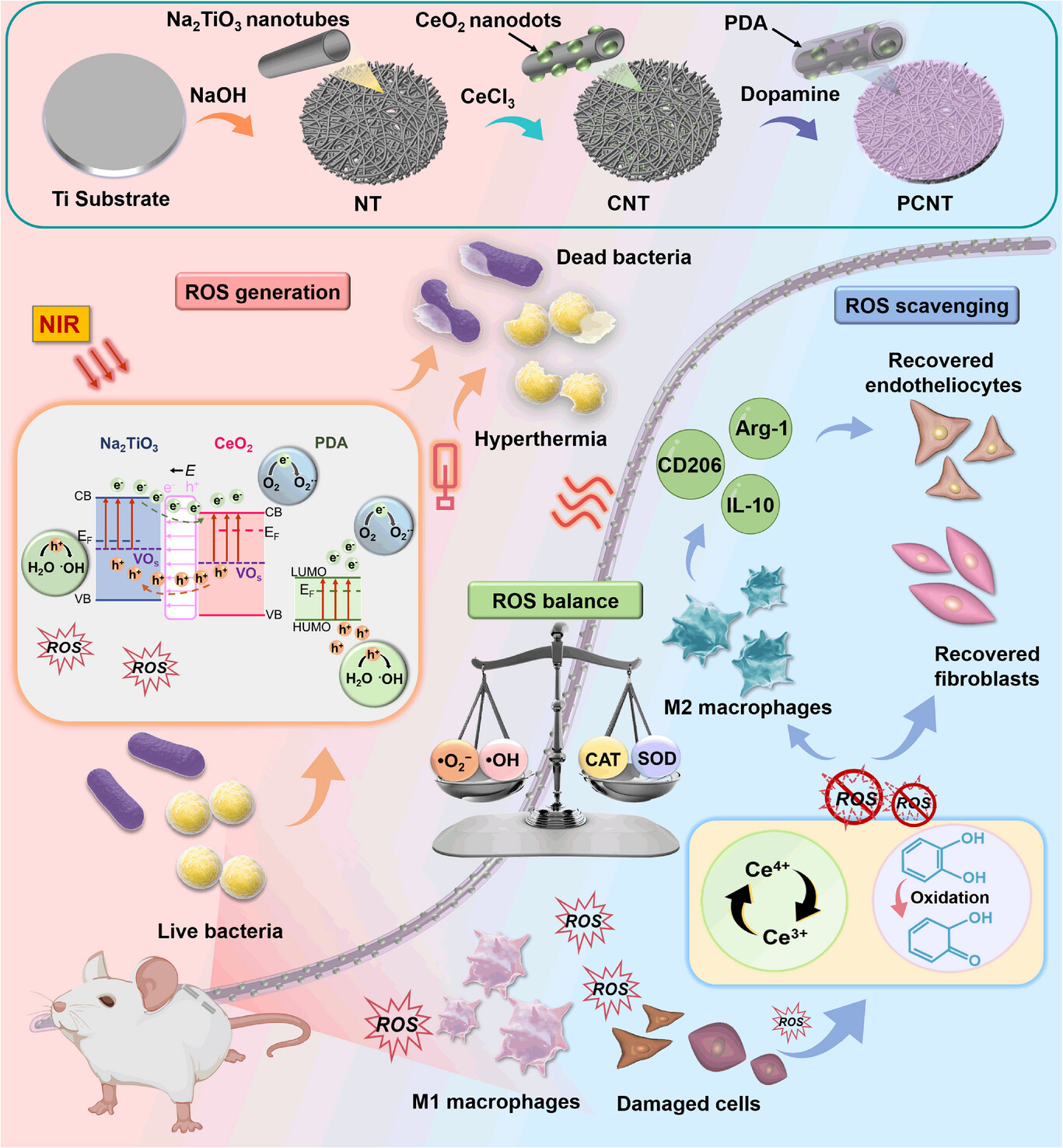Diabetes mellitus is a chronic metabolic disorder characterized by hyperglycemia, excessive reactive oxygen species (ROS), and accumulation of advanced glycation end products (AGEs). These pathological factors often lead to persistent inflammation, recurrent infections, and delayed tissue regeneration during wound healing. Titanium (Ti) alloys are widely used in hard tissue repair due to their high strength, corrosion resistance, and excellent biocompatibility. However, the bioinert nature of Ti alloys limits their ability to modulate inflammation or resist bacterial adhesion, resulting in high implant failure rates in diabetic patients—particularly for transcutaneous Ti implants (e.g. percutaneous prostheses and dental implants). Designing surface microstructures for transcutaneous Ti implants that can eliminate bacteria on demand while regulating the inflammatory microenvironment to promote tissue integration is critically important for diabetic patients.
Recently, researchers from the National Key Laboratory for Mechanical Behavior of Metal Materials at Xi’an Jiaotong University constructed a dual-catalysis mode composite coating on Ti implant surfaces, composed of Na₂TiO₃ nanotubes, CeO₂ nanodots, and polydopamine (PDA), to manipulate ROS generation and scavenging for antibacterial and tissue-regenerative purposes. The heterojunction formed between Na₂TiO₃ and CeO₂, along with oxygen vacancies (VOs) in their lattices, facilitates electron-hole pair separation. Under near-infrared (NIR) irradiation, the coating exhibits outstanding photothermal and photodynamic properties, generating localized hyperthermia and abundant ROS to synergistically eradicate bacteria. In the non-NIR mode, CeO₂ nanodots and PDA demonstrate enzyme-like activities resembling superoxide dismutase (SOD) and catalase (CAT), converting harmful ROS (e.g., O₂⁻ and H₂O₂) into harmless O₂ and H₂O. This alleviates oxidative stress in the microenvironment, accelerates the polarization of M2 macrophage phenotypes, and restores the biological functions of endothelial cells and fibroblasts, thereby promoting peri-implant tissue regeneration in diabetic models.

Figure 1. Schematic illustration of the fabrication process of PDA@CeO₂-Na₂TiO₃ coating on titanium surface and its functions in antibacterial activity, immunomodulation, and tissue integration within diabetic microenvironment.

Figure 2. (a), (b) Morphology and elemental distribution of CeO₂-Na₂TiO₃ coating; (c) Microstructure of PDA@CeO₂-Na₂TiO₃ coating; (d) MB degradation curve of coating under NIR irradiation; (e) Photocurrent response of coating under NIR irradiation; (f) ROS generation mechanism of coating under NIR irradiation; (g) Antibacterial rate of coating under NIR irradiation; (h) ROS scavenging efficiency of coating; (i) Macrophage polarization results after 3-day H₂O₂-induced damage; (j) ROS fluorescence intensity of macrophages after 1-day H₂O₂-induced damage; (k) Cell viability assay of endothelial cells post H₂O₂-induced damage; (l) Cell viability assay of fibroblasts post H₂O₂-induced damage; (m) Masson's trichrome staining images of samples 8 days post-implantation in diabetic rats; (n) Schematic illustration of tissue integration mechanism.
This study proposes a novel surface microstructure design strategy for implants with dual-catalysis modes, achieving infection control, inflammation modulation, and enhanced biointegration of Ti implants in diabetic microenvironments through ROS regulation. The work, titled "A Dual-catalysis Mode for ROS Regulation to Accelerate Biointegration of Implants in Infected Diabetic Wounds," was published in the internationally renowned journal Advanced Functional Materials.
Professor Lan Zhang and Professor Yong Han from Xi’an Jiaotong University are the co-corresponding authors, and Ph.D. candidate Huihui Xie is the first author. This research was supported by the National Natural Science Foundation of China (General Program), the Shaanxi Natural Science Foundation for Distinguished Young Scholars, Key Projects, and the Open Project of the National Key Laboratory for Mechanical Behavior of Metal Materials.
Paper Link: https://doi.org/10.1002/adfm.202423015
Prof. Lan Zhang’s Homepage: https://gr.xjtu.edu.cn/en/web/lan.zhang
Prof. Yong Han’s Homepage: https://gr.xjtu.edu.cn/en/web/yonghan


